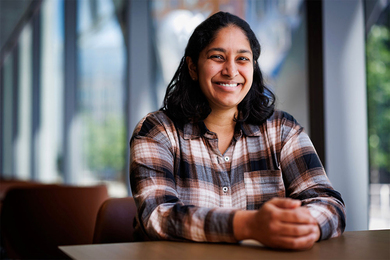Sarah Sze's whimsical fire escape at Sidney-Pacific Graduate Residence is the ninth and newest project of MIT's Percent-for-Art Program, which allots up to $250,000 to commission art for each new major renovation or building project on the Institute's campus.
Founded in 1968 and administered by the List Visual Arts Center, the program brings internationally known artists into the architectural design and planning process at MIT. In some cases, such as "Blue Poles," artwork has been commissioned after the building is completed.
The program is unusual for a private university, according to Patricia Fuller, curator of public art at MIT. The Institute is the only such place that commissions art in collaboration with building on a consistent basis, she said.
The 50-year-old process of selecting and installing art in new MIT buildings has become a routine part of campus planning today. When each project begins, the director of the List Center serves as the chair of a site advisory committee, recommending artists to the committee and reviewing the development of their proposals.
But completing the Percent-for-Art Process is not always simple or easy. As with much public art, the works themselves receive a variety of responses.
In dormitory projects, "Sometimes the students have a problem because that's their space," said Hiroko Kikuchi, education/outreach coordinator for the List Center. But the intent, she said, is not to impose art on people. "We make sure we involve them in the art selection process and educate them about the art. You can't really have 100 percent control. It's a really interesting program, but so much patience is involved."
In the case of Sidney-Pacific, the committee that selected Sze and commissioned "Blue Poles" included the architect, housemasters, house managers and students of the dorm. They chose Sze from a short list of about a dozen artist-candidates, said Fuller.
The Sidney-Pacific project was "more difficult" than some others, Fuller said, because the dorm was already built and filled with students and activities.
Other recent Percent-for-Art installations include Dan Graham's "Ying/Yang Pavilion" in Simmons Hall and Matthew Ritchie's "Games of Chance and Skill," a three-part map of time and space that graces the walls of the Zesiger Sports and Fitness Center.
Examples of art-and-architecture collaborations on the MIT campus that predate the formal Percent-for-Art Program include Harry Bertoia's altarpiece and Theodore Roszak's bell-tower, created for Eero Saarinen's MIT Chapel, built in 1955.
A version of this article appeared in MIT Tech Talk on March 22, 2006 (download PDF).





